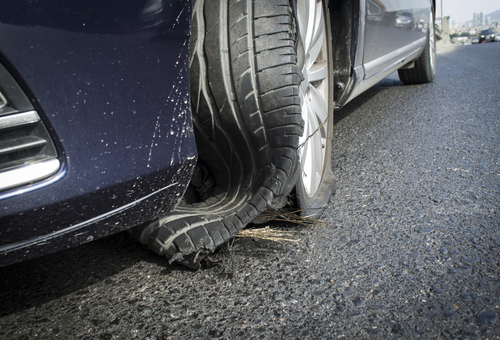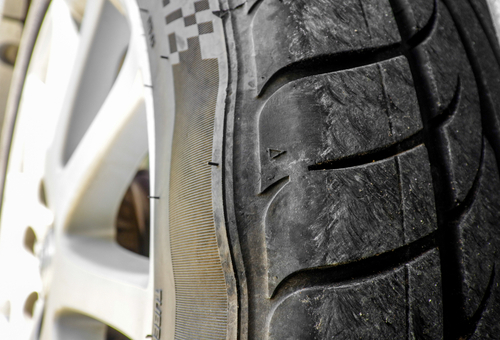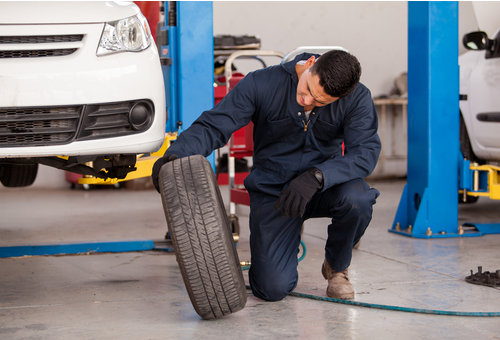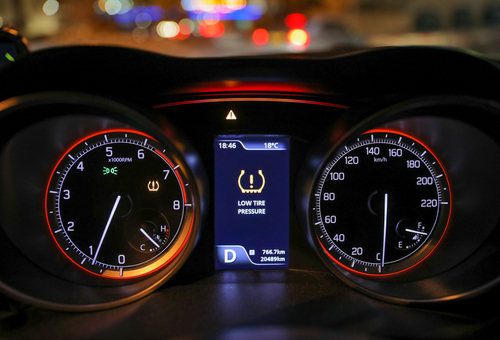
In a previous article, we discussed some issues around well-used tyres on light vehicles, and how to determine at which point such tyres should be replaced. In this article, we will discuss some of the reasons why tyres that seem to be new, (or new-ish) and are in an apparent good condition, sometimes fail prematurely. We will also take a closer look at how we, as mechanics and technicians, can contribute to general tyre safety by paying more attention to detail when we do tyre inspections. Before we get to specifics, though, let us start with saying that-
According to this study, about 40 per cent of Australian motorists are unaware of even the most basic legal aspects of proper tyre care and maintenance. Sadly, the study does not cite percentages that apply to specific areas of motorists’ lack of knowledge, but some issues lifted out by the study cover minimum tread depth, inflation pressures, and maximum allowable loads.
However, the study does cite some other concerning figures. For instance, 48 per cent of drivers surveyed said they always put off replacing their tyres for as long as possible, while 23 per cent of drivers surveyed admitted to always buying the cheapest tyre they could find. The study also found a close correlation between a driver’s age and his/her lack of knowledge about tyre safety, with more than 50 per cent of Gen Y* drivers admitting that they know little to nothing about tyre safety standards.
* At the risk of dating himself, this writer admits that he had to look up which demographic constituted Gen Y. According to this resource, which may or may not be accurate, it turns out that Gen Y is also known as “Millennials”, and are “…the demographic cohort following Generation X and preceding Generation Z. Researchers and popular media use the early 1980s as starting birth years and the mid-1990s to early 2000s as ending birth years, with the generation typically being defined as people born from 1981 to 1996.” (Source: https://en.wikipedia.org/wiki/Millennials)
So, why is this important? It is important because given that as of June 2020, Australia imported an annual average (calculated over five years) of 22.31 million loose tyres, the majority of which were for passenger vehicles and motorcycles. The rest of the 58 million or so tyres that are discarded each year come into the country already fitted to imported cars and other vehicles. It is also important because while many imported tyres come from the USA and Europe, about 60 per cent of imported tyres come from China, meaning that a large number of Chinese-made tyres may or may not conform to acceptable safety standards.
In this case, “acceptable safety standards” are enshrined in the law, so let us take a closer look at-
ADR 23 is far too long and complex to reproduce here, but we can do the next best thing, which is to highlight some of the aspects of this Design Rule where we, as mechanics and technicians, can contribute to tyre safety by educating our customers.
Briefly, ADR 23 sets out the technical specifications all passenger car tyres must conform to before any tyre can be fitted to a new or used vehicle. Among others, these specifications include-
We are all familiar with the row of figures on tyre sidewalls, and we need not rehash the basics of tyre identification here. However, many of us may not be aware of other aspects of ADR 23, so let us look at a few of these in a bit more detail, starting with-
Grossly oversized tyres are forbidden
In most jurisdictions*, ADR 23 forbids the use of aftermarket wheels or tyre/rim combinations that are more than 15mm bigger or smaller than the minimum and maximum allowable wheel size specified by the vehicle’s manufacturer. In addition, aftermarket tyre speed and load ratings must match the speed and load ratings specified by the manufacturer.
*NSW limits tyre size deviations to 7mm, as opposed to the 15mm allowed by other states and territories.
Tyres must match
ADR 23 states that the tyres on an axle must be of the (exact) same size, type, and construction. More importantly, though, ADR 23 also states that aftermarket tyres and wheels may not alter the vehicles' track width, as measured between the centre lines of two tyres on an axle.
Note that although ADR 23 does allow some deviations in some cases, ADR23 includes very specific standards that apply to specific maximum allowable track width changes. Note also that ADR 23 covers the allowed deviations in track widths in excruciating detail, since the fitment of aftermarket wheels is a common modification that often leads to handling and other safety issues.
Some modifications may require an engineering certificate
ADR 23 is clear about the use of wheel spacers to change a vehicle's track width; they are not allowed. Moreover, all aftermarket wheels must also have the same PCD (Pitch Circle Diameter) and bolt/stud hole spacing as the vehicle the aftermarket wheel will be fitted to.
Most importantly, though, all modifications to brakes and/or suspension systems to make aftermarket wheels fit on a vehicle are strictly forbidden, unless the person performing the modification(s) obtains-
These provisions do not only ensure that modified vehicles conform to minimum safety standards, but also that they continue to do so when wheels and tyres are replaced- including with standard or original wheels and tyres.
Tyre placards must be visible or available in the vehicle
It has been this writer’s experience that large numbers of drivers simply ignore the tyre placard when it comes to tyre pressures and maximum allowable loads. Apart from possible legal repercussions if the tyre placard is removed, damaged, or rendered unreadable, ignoring a vehicle manufacturer’s recommended tyre specifications is simply dangerous.
In fact, this writer also has personal experience of a tyre failure that caused a customer of his to suffer serious injuries when two newly fitted aftermarket tyres on the customer’s delivery vehicle blew out at speed while the vehicle was loaded. In this case, the tyre dealer was promoting some imported tyres “at a specially reduced price”, but the issue was that these specific tyres had a significantly lower maximum load rating than the vehicle manufacturer specified.
The customer later remarked that he had trusted the opinion and advice of the tyre dealer, who dismissed the details on the vehicle’s tyre placard as “nothing more than recommendations”, which could be safely ignored.
Of course, no reputable tyre dealer will ever dream of knowingly fitting substandard tyres to any vehicle, but having said that, it could well be that many tyre dealers may not always know what they are selling to the public, which begs this question-

Although this is one of the most hotly contested issues in the Australian motoring world, there does not seem to be a definitive answer. Moreover, the point is largely moot since the majority of tyres in use in Australia are imported, anyway.
We mentioned elsewhere that around 60 per cent of imported tyres come from China, and all, or at least, most of us have had bad experiences with Chinese-made products, including with Chinese-made tyres.
However, it also turns out that both big and small tyre brands have moved most, if not all of their production capacity to China to save on labour and other costs. As a matter of fact, one Australian tyre supplier has moved their production facility to China, and according to their CEO, Hussein Chahine, the company …” invested over one million dollars in research and development and created custom new moulds. Our manufacturers have also imported Italian machinery and hired an ex-Michelin Engineer with 25 plus years experience. This has enabled us to deliver custom 4x4 tyres designed specifically for Australian needs." (Italics added)
There is no reason to question Mr Chahine's motives in having his tyres made in China and his brand of tyres may well have qualities and characteristics that make them more suitable to Australian conditions than equivalent tyres made elsewhere.
However, this authoritative publication, which carried the story about the local tyre supplier moving to China, also states that “…While the first rounds of Chinese tyres may have been suspect, with a shift of focus towards quality engineering, this has all changed. Chinese manufacturers are now using European machinery and hiring experienced engineers to deliver tyres designed for the Australian environment”. (Italics added)
The operative words in the above statement are “may have been suspect”, and while this does not necessarily translate into “all Chinese-made tyres are bad”, or, into "Chinese-made tyres do not always conform to ADR 23 standards", the fact remains that large sections of China’s manufacturing sector are no respecters of intellectual property.
Put differently, this means that it might well be impossible to tell the difference between a high-quality tyre that was made in China, but under the supervision of a globally recognized tyre brand, and a cheap, dangerous, substandard knock-off of that same tyre that had found its’ way into the country through unregulated channels. This happens with other parts categories, so it is, therefore, almost certain that it happens with tyres, as well.
Then there is the problem of tyres that are fitted to imported cars. Most of these tyres may well have been made in sophisticated American or European factories and may, therefore, offer high levels of ride comfort, excellent handling characteristics in wet conditions, and good durability in their countries of manufacture. But then again, can we always be sure that these tyres will perform equally well on all counts in Australian conditions?
Oftentimes, this question can only be answered one way or the other after an accident had occurred, and herein lays a problem. While accurate data on road deaths in Australia is available, accidents caused by bad tyres do not always cause fatalities, and there is little to no reliable data available on the number of crashes that result directly from tyre failures, or reduced braking and cornering ability due to bad tyres.
Nonetheless, if we consider that a) almost the whole of the national car parc is riding on imported tyres, and b), that thousands of accidents occur each year, it would be reasonable to blame at least a significant percentage of crashes directly on bad, bald, or otherwise defective tyres, which begs the question of-

Since we, as mechanics and technicians can control neither the origin, nor the quality of tyres that are imported into the country, we can do the next best thing, which is to educate our customers on the dangers of driving on cheap, worn, damaged, incorrectly inflated, unsuitable, and mismatched tyres.
This is admittedly not always easy, since many of our customers are going through tough financial times, and the price of a set of tyres often represents a conflict between obeying the law, and the need to meet other, and perhaps more pressing financial commitments. Nonetheless, there are some things we can do, such as for instance, doing proper tyre inspections, and pointing out the defects in and on tyres to customers who may not have known there were issues present. Here are some details of three things we should be paying closer attention to-
The date of manufacture is always embossed on the tyre sidewall in the form of four digits. An example would be, say, "3420", meaning that in this case, the tyre was made in week 34 of the year 2020.
It is worth pointing out that ADR 23 specifies the maximum age of a tyre as 10 years, even if the tyre had never seen service. However, many studies have shown that high ambient temperatures and high humidity drastically reduce the shelf life of stored tyres, and that tyres that were stored under such conditions deteriorate extremely quickly when they are placed into service.
In the Australian context, the deterioration during service is greatly exacerbated not only by high ambient temperatures but also by the extremely high temperatures of road surfaces that accelerate the evaporation of several volatile constituents of rubber compounds. The primary function of some of these volatile substances is to prevent tyre compounds from drying out, which is exactly what happens when tyres are exposed to high temperatures over prolonged periods.
Therefore, a more reasonable maximum age for tyres in Australia is between five and six years, with a six-year limit already approaching a potentially dangerous point, because there is no telling when or how an old tyre that had lost most of its volatile constituents might fail.
The first signs of a dry tyre are small cracks that appear along the sidewalls, and sometimes, also in the tread grooves. Note that this condition can occur at any tread depth- and even in tyres that are ostensibly brand new.
This is perhaps more critical on commercial vehicles that carry loads than it is on passenger vehicles, but despite that, there is one principle of load ratings that apply equally to all tyres regardless of their size, type, or application. Below is an example of that principle at work-
We can use any tyre in this example, but let us use a tyre labelled as 285/45R22 114H, made by brand “X”. This tyre’s specifications say that at an inflation pressure of 2.62 bars, its load-carrying capacity is 1124.9kg. If the inflation pressure is raised to the maximum allowable limit of 2.82 bars, the tyre's load-carrying capacity increases to 1179.7kg. However, increasing the inflation pressure to above 2.82 bars does not increase the load-carrying capacity. Worse, though, tyres that are inflated to beyond their recommended maximum allowable inflation pressures could sustain serious structural damage that is often not immediately visible or apparent.
In practice, all tyres are subject to this inflation pressure/load carrying capacity relationship, but in high ambient temperatures, a tyre that operates on super hot road surfaces can reach its maximum load-carrying capacity at significantly less than its specified maximum inflation pressure.
These deviations are not always linear, and what applies to one tyre/rim combination may not apply to the same tyre/rim combination on another vehicle. However, since it is impossible to guess at which inflation pressure a tyre reaches its maximum load-carrying capacity, it helps to start a tyre assessment at the right starting point.
In this case, the right starting point would be a copy of the TYRE AND RIM ASSOCIATION STANDARDS MANUAL, which lists the technical specifications for all tyres that are used in Australia. This manual is compiled using data obtained from the Tire & Rim Association Inc. in the USA, as well as the European Tyre & Rim Technical Organization, both of which are among the world's leading technical bodies. Moreover, the manual also lists recommended applications, which makes it easy to check if the tyres on your customer's car are suitable for that application. Therefore, we strongly recommend that you obtain a copy of the manual- even if your primary duties do not involve tyre sales and/or tyre service.

While factory-fitted* tyre pressure monitoring systems have their (limited) uses, these systems are not only notoriously inaccurate; they also typically only trigger a warning when a tyre is underinflated by about 25 per cent.
* As a general rule, most aftermarket TPMS that cost more than two hundred dollars or so not only consistently outperform factory-fitted systems, they are also vastly more reliable than almost all factory-fitted systems.
The operative word here is "about" because this writer has encountered tyres on customers' cars that were underinflated by 40 per cent and more, without the TPMS triggering warnings. Sadly, many car owners regard the TPMS in their vehicles as a replacement for regular tyre checks, which can sometimes make it very difficult to persuade some drivers that regular checks for inflation pressure and to detect abnormal wear patterns is still required.
In addition, factory fitted TPMS's are not only often complex, finicky, and prone to failure; they are also often difficult to diagnose and/or calibrate even with high-end generic scan tools. In fact, on most late-model vehicles the TPMS can only be diagnosed and calibrated with application-specific tools and software, and then only in procedures that can take an hour or more.
Nonetheless, the hassle involved in calibrating a factory-fitted TPMS should not discourage us from doing it. In fact, when The Motor Vehicle Service and Repair Information Sharing Scheme comes into force in July this year (2022), we in the independent repair industry might encounter a greatly increased demand for this service, simply because most independent workshops can usually do it cheaper than the dealerships can, which leaves us with this-
Tyres are perhaps the best example of life-and-limb components on vehicles of all categories, and therefore, it is up to us to learn how to assess tyres properly apart from checking that the tread depth is more than 1.5mm across the width of the tread.
We also need to check for evidence of damage to the sidewalls on both sides of the tyre, in addition to both verifying the age of the tyres on our customer's cars and verifying that the tyres on each axle match in terms of size, diameter, load rating, speed rating, and direction of rotation on directional tyres. All of the above checks and verifications count for nothing if a directional tyre is mounted the wrong way round, as has been known to happen.
If we could do all of the above, and perhaps a little more, such as checking the condition and inflation of the spare tyre and noting abnormal wear patterns when we do vehicle safety inspections, we will have gone a long way towards improving tyre safety in general, and the safety of our customers, in particular, and that can never be a bad thing.